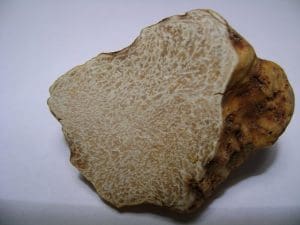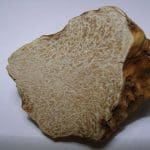White Truffle / Autumn / Winter / Edible
Scientific Name
Tuber magnatum
Common Names
White Truffle, Piedmont truffle, White gold
Family
Tuberaceae
Habitat
They are mycorrhizal and grow just beneath the surface near oak, popular, beech and hazel trees. Unfortunately they aren’t found in the UK, they’re famously found in the countryside around Piedmont in Italy but can also be found in France, Croatia and Bosnia and Herzegovina. Who knows perhaps climate change might bring them further north.
Description
A delicious and much sought after fungus, they are known as “Truffle of the White Madonna” in Italy. Loved by chefs, the record price for a truffle is £165,000 for a specimen the weighed 1.5 kg!!!
Identifying Features:
Cap:
The roughly ball shaped, fruit bodies can be up to 10cm in diameter. Their skin or peridium is pale brown to cream in colour. They lack a stem or gills, their spores are produced inside and are spread when animals eat and later deposit them. They are normally harvested between September and December.

Smell:
A nutty/mushroom type smell.
Spores:
Black to brown.
Uses
In food
They are much prized by chefs and have a lovely hazel nutty, fungal flavour. They are one of the most expensive food stuffs in the world.
As they are quite expensive, a good way to make the most of them is to store the truffle in a basket full of eggs. As the eggs shells are permeable the truffle flavour will transfer and makes the most amazing scrambled eggs.
After that they can be finely sliced or grated over savoury dishes or infused in oil to add a heady umami kick.
Notes on Herbal Uses
Truffles are general contain many important vitamins and nutrients including vitamin C, phosphorus, sodium, calcium, magnesium, manganese and iron.
They contain lycopene, gallic acid and homogentisic acid, which are important amino acids that studies show may lower your risk of conditions such as such as cancer, heart disease and diabetes.
They are also said to have aphrodisiac properties and have been used to boost fertile.
Known hazards
None known.
Potential lookalikes
The main look-alike I’m aware of is the Whitish truffle (Tuber borchii) but this grows later in the season, in off white in colour and is also edible.
I specialise in wild plants and fungi of the UK and I have never had the opportunity to go truffle hunting abroad. There aren’t too many lookalikes that I’m aware of but I would certainly want to be guided by a local expert.
Extra Notes from the Foragers
Each year The International Alba White Truffle Fair (Fiera Internazionale del Tartufo Bianco d’Alba) takes place in Italy, it’s the world’s biggest event dedicated to truffles. They are celebrated through foods, song, dance, music and poetry.
Although some species of truffle have been cultivated for some time, (even in Britain) it is only recently that the White truffle was. In 2008 a French company started selling trees inoculated with truffle spores for commercial production, in 2018 the first truffles were harvested. So it may be possible to grow this species in the UK soon.
References:
https://en.wikipedia.org/wiki/Tuber_magnatum
https://www.bbcgoodfood.com/recipes/collection/truffle-recipes









Leave a Reply
You must be logged in to post a comment.